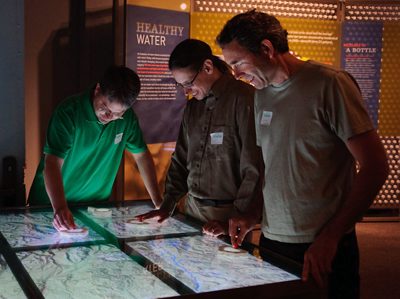UIC’s Interactive RainTable Featured in New Exhibit at The Field Museum
June 17th, 2009
Categories: Applications, Devices, Education, Multimedia, Museums, Software, User Groups, Visualization

About
CHICAGO, June 17 - Water, a multi-faceted exploration of water’s influence on Earth framed as a major traveling museum exhibit, opens today at The Field Museum. The exhibit features an interactive, real-time computer graphics display system, dubbed RainTable, which was invented at the University of Illinois at Chicago (UIC).
RainTable is an ultra-high-resolution, tiled-LCD tabletop application that displays topographical and aerial map data. Multiple users can slide cloud-shaped pucks over any region on the map to generate virtual rainfall that cascades over the features of the landscape. The behavior of the virtual watershed is highly realistic because it relies on accurate height map information.
Both RainTable and the display hardware, called LambdaTable, were developed at UIC’s Electronic Visualization Laboratory (EVL), a graduate research laboratory that specializes in the research and development of networked, high-resolution visualization, collaboration, and virtual-reality display hardware and software systems.
EVL and its collaborators at the Science Museum of Minnesota and the National Center for Earth-surface Dynamics conceived of RainTable as an interpretive technique to educate the general public about water dynamics. The museum, along with exhibit co-organizers at the American Museum of Natural History in New York, commissioned the system for the exhibit, now traveling coast-to-coast before going abroad.
The Science Museum of Minnesota is a longtime EVL collaborator, and has hosted several EVL graduate students as summer interns throughout the RainTable design and prototype phases. RainTable was added to Water at its previous stop in Minnesota, after sufficient time for the museum to “road test” the display system on its exhibit floor for several months.
Viewing the user-generated virtual rainfall on large expanses of land shows museum-goers the interconnectedness of water bodies - one of the takeaway messages of the exhibit, according to Bette Schmit, lead developer on the Water exhibition team at the Science Museum of Minnesota. All water on Earth is linked in a vast cycle, from oceans to wetlands, rainwater to groundwater.
“Visualizing the dynamics of water flow over a landscape is an interesting computer-generated particle physics simulation, but it also visually informs people about the consequences of polluting or releasing contaminants upstream,” said Dr. Andrew Johnson, UIC associate professor of computer science and project lead at EVL. “Flowing water knows no political, state, or national boundaries.”
A new multi-user, multi-touch version of RainTable will go onto the Science Museum of Minnesota exhibit floor in the near future. It will run on a new EVL-developed display system called TacTile, enabling museum-goers to generate the rainfall using their fingertips.
The TacTile version of RainTable has already been demonstrated at Supercomputing 2008, a major international computer science conference, and most recently at the American Association for the Advancement of Science annual meeting in February 2009.
The U.S. National Science Foundation (NSF) provided major support for Water with leadership support from the Freshwater Society and Tamarind Society in association with the Johns Hopkins Center for a Livable Future. NSF also provided funding to UIC for the development of the tabletop display systems.
Water is organized by the American Museum of Natural History, New York, and the Science Museum of Minnesota, St. Paul, in collaboration with The Field Museum, Chicago; Great Lakes Science Center, Cleveland; Instituto Sangari, São Paulo, Brazil; National Museum of Australia, Canberra; Royal Ontario Museum, Toronto, Canada; San Diego Natural History Museum; and Science Centre Singapore with PUB Singapore.
Water is on exhibit at The Field Museum from June 17 to September 20